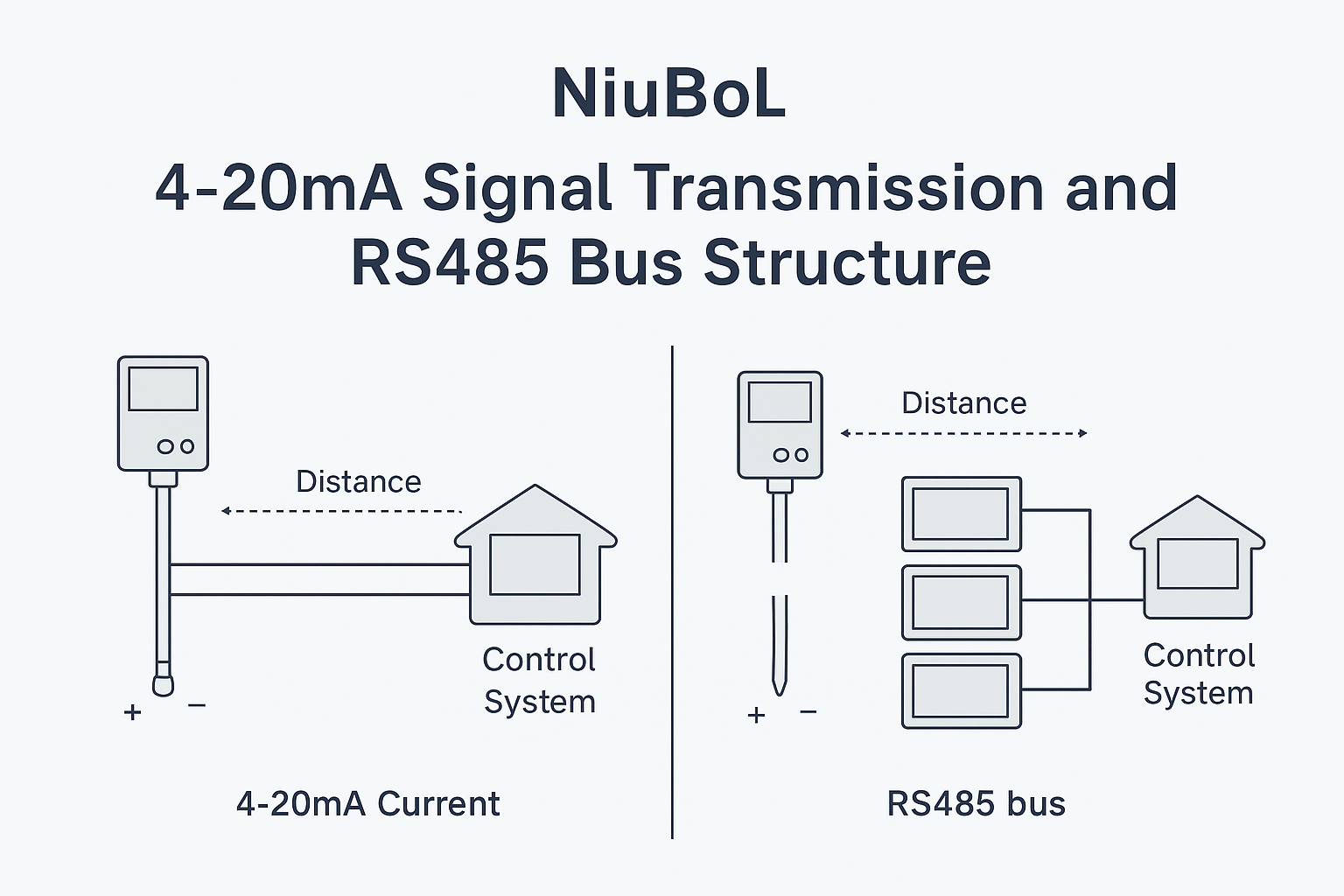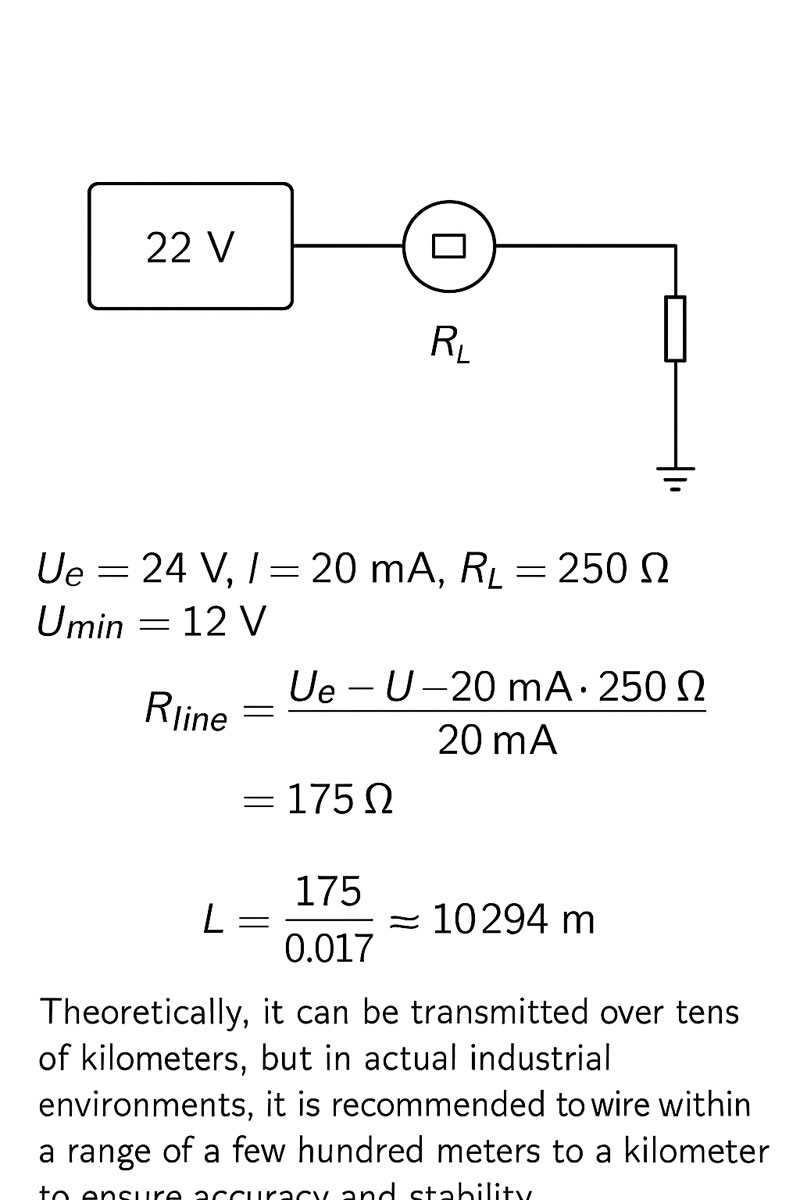

— Blogs —
—Products—
 Consumer hotline +8618073152920
Consumer hotline +8618073152920 WhatsApp:+8615367865107
Address:Room 102, District D, Houhu Industrial Park, Yuelu District, Changsha City, Hunan Province, China
Product knowledge
Time:2025-11-16 15:36:19 Popularity:117
As industrial automation and intelligence advance, temperature and humidity transmitters play a pivotal role in industrial production, agricultural greenhouses, smart buildings, and scientific research. They convert environmental temperature and humidity data into collectible electrical signals for processing by control systems, remote monitoring platforms, or IoT ecosystems.
The most common industrial signal transmission methods are 4-20mA analog current output and RS485 digital communication. Each has unique strengths in anti-interference capability, transmission distance, accuracy, installation complexity, and cost. This article comprehensively analyzes both technologies—from principles and applications to selection guidelines and FAQs—to provide a clear decision-making framework.

The 4-20mA current loop is one of the most classic industrial sensor outputs, offering:
- Strong Anti-Interference: Current signals are unaffected by wire length or resistance changes, ensuring stability even in EMI-heavy environments.
- Two-Wire Power Supply: 4mA serves as the sensor’s standby current; signal wires double as power lines, simplifying wiring.
- Open-Circuit Detection: Non-zero lower limit (4mA) enables instant fault detection if the loop breaks.
- Intrinsically Safe: Low power in the loop prevents sparks in flammable environments.
> Tip: 4-20mA is ideal for industrial environment monitoring, greenhouse control, and explosion-proof zones.

Distance depends on:
- Supply Voltage (Ue): Higher voltage = longer range
- Sensor Minimum Operating Voltage (Umin): Must support full load (20mA)
- Load Resistance (RL): Current-to-voltage conversion resistor
- Cable Resistance (Rline): Thicker, shorter cables = better performance
Given:
- Ue = 24V
- I = 20mA
- RL = 250Ω
- Umin = 12V

In theory, over 10km is possible. In practice, limit to a few hundred meters to 1km for accuracy and reliability in industrial settings.
3. Limitations of Voltage Signal Transmission
DC voltage signals decay with cable length and are highly susceptible to interference, making them unsuitable for long-distance industrial use.
> GB/T 3369.2-2008 Analog Signal Specification explicitly states: Voltage signals are not recommended for long-distance industrial transmission.

RS485 is an industrial-standard differential serial communication protocol supporting half-duplex or full-duplex transmission. It enables multi-drop bus topology, connecting temperature/humidity data to PLC, DCS, or IoT platforms.
- Long-Distance Communication: Reliable over 1,000+ meters
- Multi-Node Support: Up to 32 devices per bus (expandable with repeaters)
- High Digital Accuracy: No degradation from resistance or voltage drop
- Easy Integration: Seamless with industrial IoT, smart buildings, and PLC systems
- Complex configuration (requires Modbus RTU/ASCII or similar protocols)
- Needs gateway or data parser, increasing cost
- Usually requires separate power supply (not two-wire)
> Tip: RS485 is best for remote multi-point monitoring, industrial IoT, and high-precision applications.
| Feature | 4-20mA (Analog) | RS485 (Digital) |
| Anti-Interference | Medium-High | High |
| Transmission Distance | Hundreds of meters to 10km+ | 1,000+ meters (reliable bus) |
| Multi-Node Support | Not suitable | Up to 32+ nodes |
| Accuracy | Affected by load & interference | High, no degradation |
| Installation Complexity | Simple (2-3 wires) | Requires protocol & addressing |
| Cost | Low | Relatively higher |
| Power Supply | Two-wire / three-wire | Usually separate power |
| Scenario | Recommended Signal |
| Single point, short distance, simple wiring | 4-20mA |
| Long distance, multi-point, high accuracy | RS485 |
| Tight budget but need reliable measurement | 4-20mA |
| Industrial IoT & digital management | RS485 |
Pro Tips:
- 4-20mA: Minimize connectors to prevent signal loss
- RS485: Use shielded twisted pair + termination resistors for stability
- Scenario: Workshop temperature/humidity control for process stability
- Signal Choice: 4-20mA – simple wiring, sufficient anti-interference
- Scenario: Real-time monitoring for irrigation & ventilation
- Signal Choice: RS485 – multi-sensor bus, cloud data upload
- Scenario: HVAC system integration & remote monitoring
- Signal Choice: RS485 – easy integration with building automation
- Scenario: Long-term high-precision data logging
- Signal Choice: RS485 or Dual Output (4-20mA + RS485)
> Tip: Some NiuBoL transmitters offer dual output, supporting both local analog control and remote digital acquisition.
Theoretically over 10km; practically 300m–1km for stability.
Standard: 32 nodes; expandable with repeaters.
4mA powers the sensor; enables open-loop fault detection.
Possible, but consider system compatibility, protocol parsing, and cost.
Ensure sufficient voltage, use proper gauge, minimize joints, avoid EMI sources.
Use shielded twisted pair, termination resistors, and isolators if needed.
High-end models include temperature compensation; impact is minimal.
4-20mA is inherently safe; RS485 requires intrinsically safe barriers.
Yes—NiuBoL dual-output models support local analog + remote digital.
Copper has low resistance → longer range; aluminum requires larger gauge or shorter runs.
Modbus RTU – widely supported by PLCs, DCS, and IoT platforms.
For high-precision industrial/scientific use: calibrate every 6–12 months.

Temperature and humidity transmitters are essential for environmental monitoring in industry, agriculture, and smart buildings.
- 4-20mA: Ideal for single-point, short-distance, simple, and explosion-proof applications
- RS485: Perfect for long-distance, multi-point, high-precision, and IoT-integrated systems
NiuBoL offers a full range of transmitters supporting 4-20mA, RS485, and dual-output models to meet diverse needs—delivering reliable, accurate, and remote-capable environmental monitoring.
Call to Action: Contact us today for a customized transmitter selection plan or technical datasheet tailored to your application.
Prev:NiuBoL Frequency Vibration Solar Insect Killer Lamp – Green Pest Control for Agriculture
Next:NiuBoL Ultrasonic Wind Speed and Direction Sensor: Precision and Reliability in Wind Measurement
Related recommendations
Sensors & Weather Stations Catalog
Agriculture Sensors and Weather Stations Catalog-NiuBoL.pdf
Weather Stations Catalog-NiuBoL.pdf
Related products
 Combined air temperature and relative humidity sensor
Combined air temperature and relative humidity sensor Soil Moisture Temperature sensor for irrigation
Soil Moisture Temperature sensor for irrigation Soil pH sensor RS485 soil Testing instrument soil ph meter for agriculture
Soil pH sensor RS485 soil Testing instrument soil ph meter for agriculture Wind Speed sensor Output Modbus/RS485/Analog/0-5V/4-20mA
Wind Speed sensor Output Modbus/RS485/Analog/0-5V/4-20mA Tipping bucket rain gauge for weather monitoring auto rainfall sensor RS485/Outdoor/stainless steel
Tipping bucket rain gauge for weather monitoring auto rainfall sensor RS485/Outdoor/stainless steel Pyranometer Solar Radiation Sensor 4-20mA/RS485
Pyranometer Solar Radiation Sensor 4-20mA/RS485
Screenshot, WhatsApp to identify the QR code
WhatsApp number:+8615367865107
(Click on WhatsApp to copy and add friends)
